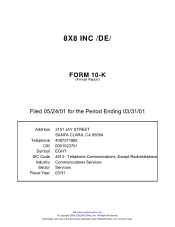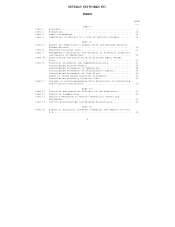8x8 2001 Annual Report Download - page 7
Download and view the complete annual report
Please find page 7 of the 2001 8x8 annual report below. You can navigate through the pages in the report by either clicking on the pages listed below, or by using the keyword search tool below to find specific information within the annual report.substantially lower the cost of telephone and equipment costs to these customers and to increase the breadth of features available to the end-
user. Next generation services like full-motion, two-way video are now within the bandwidth available to broadband customers, whether
business or residential. To enable such new products to take hold, service and equipment suppliers need semiconductor products and software
to connect input and output devices to the networks and to build system functionality.
TECHNOLOGY AND PRODUCTS
The Company has developed a broad range of communication technologies, including semiconductors, embedded software, system design,
telephony call management software, and VoIP service creation software and related development tools.
The Company has leveraged its technologies to develop the following product lines: semiconductors and embedded software designed for IP
telephony and videoconferencing applications, developed and marketed by NME; hosted iPBX solutions, developed and marketed by Centile;
and VoIP service creation software.
SEMICONDUCTORS AND EMBEDDED SOFTWARE
The Company's subsidiary, NME, develops and markets a range of technology products, including semiconductors, embedded software, system
software, and reference designs, that allow telecommunication equipment OEMs to build IP phones and IP to PSTN gateway products and to
add IP telephony functions to DSL, cable, and wireless modems. Additionally, NME provides semiconductors and embedded software for use
in videoconferencing applications. The following sections describe NME's technology and related products more fully.
Technology
SEMICONDUCTOR ARCHITECTURE -- NME's semiconductors are based on programmable processor architectures that enable
implementation of IP telephony and videoconferencing applications in a highly efficient manner. NME's semiconductor architectures employ
32-bit reduced instruction set computer (RISC) microprocessor cores, which execute the embedded applications software. Some of NME's
semiconductors also employ a 64-bit Single Instruction Multiple Data (SIMD) digital signal processor (DSP) to accelerate the processing of
signal processing intensive operations.
NME's RISC processor cores use a proprietary instruction set specifically designed for multimedia communication applications. The RISC
cores control the overall chip operation and manage the input/output interface through a variety of specialized ports which connect the chip
directly to external host, audio, and network subsystems. The cores are programmable in the C programming language and allow customers to
add their own features and functionality to the device software provided by NME. The RISC cores access 32-
bit instructions and data through a
bus that interfaces to internal and external static random access memory (SRAM). The RISC core in the Audacity-T2 semiconductor also
contains an extended instruction set to execute specialized DSP instructions.
NME's DSP core architecture is a SIMD processor that implements computationally intensive video, audio, and graphics processing routines as
well as certain digital communication protocols. The VCP and LVP DSP cores operate at frequencies up to 72 MHz, the VCPex and Audacity-
ITP DSP cores operate up to 80 MHz, the Audacity-
T2 DSP core operates up to 150 MHz, and the VP7 DSP core operates up to 100 MHz. The
DSP cores are programmable with a proprietary instruction set consisting of variable-length 32-bit and 64-bit microcode instructions that
provide the flexibility to improve algorithm performance, enhance audio and video quality, and maintain compliance with changing digital
audio, video, graphics, and communication protocol standards. The DSP cores access their instructions through an internal bus that interfaces to
on-chip SRAM and read-only memory (ROM) that is preprogrammed with video and audio processing subroutines. The combination of RISC
and DSP cores can be reconfigured through a change of application software. This flexibility allows for the implementation of fundamental
processing steps that form the basis of Media Gateway Control Protocol (MGCP), Session Initiation Protocol (SIP), and H.323
3




















